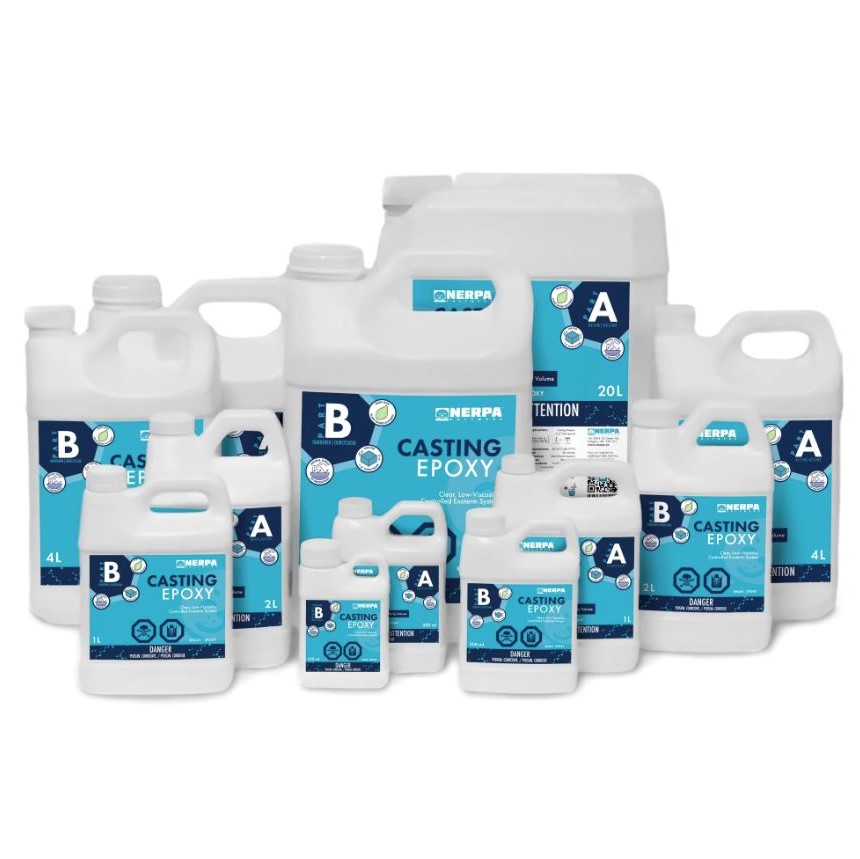Nerpa Casting Epoxy Resin is a made-in-Canada, low-odor, non-yellowing, made from recycled bio-based materials, designed to make it easy to create professional results. Here are 5 tips to make your next resin casting project a success.

1. How to avoid bubbles in my project?
Temperature matters
As a preventive measure, we recommend working with resins warmed to their working temperatures. This helps maintain the viscosity in the range specified for the product and ensures optimal air release. Accordingly, do not use cold products. Warm the product by placing containers in a bucket of room temperature (not hot water) water and letting it sit for several minutes.
In summary, a lower than optimal working temperature will increase the viscosity and worsen air release properties.
Take care when mixing
Epoxy mixing should be done in such a way as to minimize air entrapment. Accordingly, if you use a drill mixer, choose a rotation speed such that no vortex occurs when mixing.
Time is of the essence
All the manipulations with resin, such as pouring, adding pigments, and swirling should be done within the specified working time.
Seal wood before pouring
Large slabs of wood have air entrapped in pores and in voids. If wood isn’t properly sealed, air will try to escape the moment you pour your casting epoxy. This can leave visible bubbles inside your cast. A key point is to seal your wood before pouring casting epoxy.
After mixing epoxy resin and hardener, you may want to use the degassing chamber for projects with advanced shapes and requirements.
Learn more about removing bubbles in Nerpa Resin
2. Why did my resin project not cure properly?
There can be a few reasons why the Nerpa Casting Epoxy Resin didn’t cure as expected. Knowing these scenarios in advance helps you avoid untimely and costly mistakes when working with them.
Mixing ratio
Never alter the epoxy mix ratio. Epoxy resin and hardener molecules have active sites, designed to react with each other. It’s important to stick to the mix ratio so that all molecules have reacted with each other, which builds a solid matter.
The mix ratio is affected when there is more hardener than resin molecules. Not every hardener molecule will be able to find a corresponding resin molecule to react with, thus leaving some of the hardener molecules not fully reacted. This scenario affects the quality of the molecular network and properties of the cured epoxy, such as hardness and glass transition temperature.
A similar effect occurs if there is a scarcity of hardener molecules in the mixture. The reaction cannot be complete; thus, cured epoxy will experience less-than-ideal properties.
Temperature
Don’t use the epoxy at temperatures significantly below the recommended working temperature because you will experience problems with solidifying. The reaction will slow down after the gelling point and remain incomplete.
It is also possible that the chemical reaction will not even start if the ambient temperature is too low.
The volume of the pour and project dimensions
Visit our Coating Epoxy Basics and Casting Epoxy Basics to learn more about the volume and dimensions of the epoxy pours you can do with our products.
Proper mixing techniques
Proper mixing of Nerpa Casting Epoxy Resin is essential for good curing. Mix Part A and Part B for 5 minutes scraping the walls of the mixing pail from time to time. Poorly mixed epoxy will result in clusters of only resin molecules and only hardener molecules with no pair to react with. Obviously, this would lead to poorly cured material with mediocre properties.
3. Can my epoxy crystallize?
Epoxies maintain liquid properties below the freezing point, therefore, unmodified epoxy resin can stay in a liquid state for a long time. Still, freeze/thaw cycles or impurities could cause the epoxy to crystalize and become a soft white solid matter. Fortunately, epoxy can be heated to 55°C and become liquid again without losing any properties. Our epoxies are crystallization resistant. All of them have passed the ISO4895 test for crystallization resistance. It is improbable that you will experience problems with the crystallization of Nerpa Epoxies.
4. Curing time. How long does it take for Nerpa Casting Epoxy Resin to solidify?
Ambient temperature, shape, and volume of the pour will affect curing times for epoxy resin. Visit our Casting Epoxy basics and Coating Epoxy basics to find information about cure behavior of our products.
5. Is Nerpa Epoxy biodegradable?
Nerpa Epoxy is not biodegradable. The decomposition of fully cured epoxy under normal conditions is not happening. As a result, epoxy can be used in many industrial applications. Nerpa Casting Epoxy Resin gives your project a protective coating that allows it to remain as lovely and shiny as when you made it, even after several years of use. If our epoxy was biodegradable, sunlight and microorganisms would cause decomposition to begin the moment you use it.
